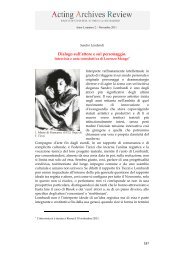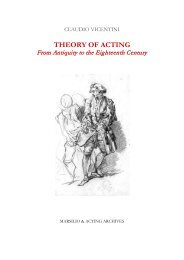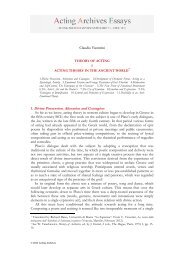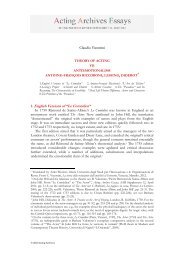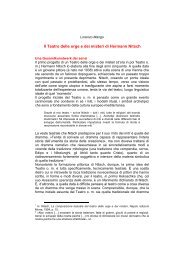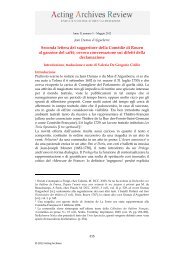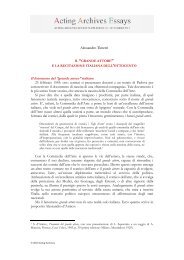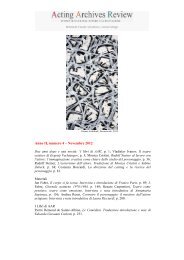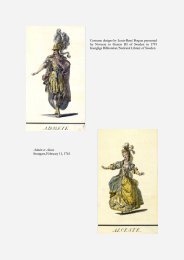Maria Ines Aliverti_The Miniatures of Jean Louis ... - Acting Archives
Maria Ines Aliverti_The Miniatures of Jean Louis ... - Acting Archives
Maria Ines Aliverti_The Miniatures of Jean Louis ... - Acting Archives
Create successful ePaper yourself
Turn your PDF publications into a flip-book with our unique Google optimized e-Paper software.
AAR <strong>Acting</strong> <strong>Archives</strong> Essays Supplement 10 – April 2011<br />
posing sessions with the actors 75 and quite probably made use <strong>of</strong> a camera obscura to<br />
frame the whole scene and focus on the details. 76<br />
If Faesch already had a portable camera obscura at his disposal when he made his<br />
first miniatures <strong>of</strong> actors between 1765 and 1768, his expertise in optical devices<br />
could have improved during the period <strong>of</strong> his journeys to London (1768-1775/early<br />
1776), both through his contacts with Garrick’s circles and because the market for<br />
optical devices in London was particularly thriving. 77 Here Faesch could have<br />
discovered more refined systems <strong>of</strong> camera obscura such as the advanced version<br />
that the enterprising English instrument maker William Storer (1750-1799) patented<br />
in June 1778, but that he had begun to experiment in the preceding years: it was<br />
called – thanks to the patents obtained by the inventor – the ‘Royal Delineator’. <strong>The</strong><br />
camera obscura designed by Storer can be considered, due to its portability and its<br />
technical superiority, to be the true ancestor <strong>of</strong> the photographic camera. This optical<br />
apparatus produced images <strong>of</strong> remarkable clarity, without the need to capture the<br />
subject in daylight, and was thus suited to posing indoors. Storer’s optical box could,<br />
in fact, even be used in a candle-lit room.<br />
75 On the method used by Z<strong>of</strong>fany to paint the actors there is some uncertainty <strong>of</strong> opinion. Helen R.<br />
Smith makes the following hypothesis about the way the studio sessions were organized: ‘Although<br />
Z<strong>of</strong>fany’s paintings were composed in the studio and the figures probably painted one by one as the<br />
actors had time to pose in costume, they suggest, at their most successful, the vivid interactions <strong>of</strong> an<br />
actual performance’ (H. R. Smith, David Garrick 1717-1779: A Brief Account, p. 53). I agree with Smith<br />
with regard to the way the actors posed in the studio. She does not, however, make any mention <strong>of</strong><br />
the possible use by Z<strong>of</strong>fany <strong>of</strong> optical instruments. Since we possess a few painted sketches by<br />
Z<strong>of</strong>fany, we can state that he certainly did not exclude the sketching phase. This does not contrast,<br />
however, with the fact that he drew the actors as they posed with the help <strong>of</strong> the camera obscura,<br />
probably executing both the group <strong>of</strong> actors and each actor individually, and then placed the figures in<br />
a scenic setting based on the original theatrical setting, perhaps enriched with details <strong>of</strong> his own<br />
invention. This solution seems to me more likely than settings reconstructed in the studio. This<br />
explains the discords that Mary Webster, the author <strong>of</strong> an important monograph on Z<strong>of</strong>fany,<br />
observes: ‘<strong>The</strong> figures appear forced in their liveliness as <strong>of</strong> an actor performing a piece <strong>of</strong> stage<br />
business, and at times the setting does not fuse with them, either from faults <strong>of</strong> perspective and<br />
proportion or from excessive concentration on detail’, Mary Webster, Johann Z<strong>of</strong>fany 1733-1810, (exh.<br />
cat., London, National Portrait Gallery, 14 January-27 March 1977), London, NPG, 1977, p. 10. <strong>The</strong>se<br />
discords, which Webster is unable to explain, can, however, be explained very well if we surmise that<br />
Z<strong>of</strong>fany used a procedure similar to that <strong>of</strong> Faesch. It is highly unlikely, however, that Z<strong>of</strong>fany drew<br />
inspiration directly from theatrical performance. <strong>The</strong> first theatrical conversation piece painted by<br />
Z<strong>of</strong>fany for Garrick is David Garrick in ‘<strong>The</strong> Farmer’s Return’ (Biddick Hall, Lord Lambton Collection),<br />
exhibited at the Society <strong>of</strong> Artists in April 1762. In this case the short lapse <strong>of</strong> time between the<br />
premiere <strong>of</strong> Garrick’s interlude (20 March) and the exhibition <strong>of</strong> the painting confirms that the work<br />
must have been painted during the rehearsal <strong>of</strong> the pièce, in order to enable the rapid publicity that<br />
Garrick sought.<br />
76 <strong>The</strong> use <strong>of</strong> the camera obscura was widespread among painters <strong>of</strong> the time. Sir Joshua Reynolds<br />
(1723-1792), who was among the first supporters <strong>of</strong> William Storer’s ‘Royal Delineator’, also used one.<br />
As did another painter, who had emigrated from Paris to London in 1771, Philip Jacques de<br />
Loutherbourg (1740-1812), who was also introduced to David Garrick by Monnet and immediately<br />
employed by the actor and stage director as scene painter at the Drury Lane. In strict association with<br />
his innovative practice <strong>of</strong> set design, Loutherbourg carried out pioneering experiments, such as the<br />
famous Eidophusikon, a multimedia optical show staged in a miniature playhouse which opened on<br />
26 February 1781 in Lisle Street, now Leicester Square.<br />
77 In London, even more than in Paris, there was a proliferation <strong>of</strong> optical shops and workshops. See<br />
L. Mannoni, Le grand art, pp. 132-133.<br />
32



